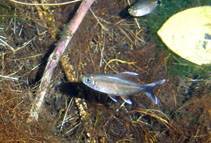| Family: |
Characidae (Characins; tetras), subfamily: Stethaprioninae |
| Max. size: |
8.53 cm SL (male/unsexed); max.weight: 7.7 g |
| Environment: |
pelagic; freshwater; depth range 0 - 1 m |
| Distribution: |
South America: known only from its type locality in the upper Rio Miranda, Brazil. |
| Diagnosis: |
Dorsal soft rays (total): 11-11. This species differs from other congeners, except intermedia and dichroura by the following combination of characters: presence of a black posterior margin on each caudal-fin lobe, and presence of a black lozenge-shaped pigment blotch on the caudal peduncle that extends to the posterior limit of the median caudal-fin rays; the short 7 gill rakers on the upper limb of the first gill arch distinguish bonita from the 2 similar species that possess 10 elongate gill rakers on the upper limb an d18 on the lower limb of the first gill arch (Ref. 51265). |
| Biology: |
Collected in marginal backwaters with low current speeds (about 0.1 m/sec) in up to 1 meter depth. Occurs primarily near the water surface, swimming in schools up to 10-30 individuals. Stomach contents and observations indicate that this species feeds mainly on terrestrial insects (dipterans and coleopterans) from the surrounding riparian forest. The insects are captured via surface picking and drift feeding (Ref. 51265). |
| IUCN Red List Status: |
Least Concern (LC); Date assessed: 07 November 2018 Ref. (130435)
|
| Threat to humans: |
harmless |
Source and more info: www.fishbase.org. For personal, classroom, and other internal use only. Not for publication.

